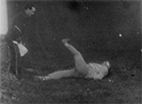Epileptic Seizures, Nos. 1-8 - Walter G. Chase
- Unseen Cinema Collection |
- 1905 |
- 22 minutes |
- B&W |
- SILENT
Rental Format(s): Digital File
Maker: Dr. Walter G. Chase
Assisted by Drs. Spratling, Collier, Shanahan, and Ross
Production: American Mutoscope and Biograph Co.
Location: Craig Colony for Epileptics, Soneya, New York
Original format: 35mm silent film 1.33:1 speed at 14-16 fps.
Technical note: Visible artifacts reflect duplication of original 35mm paper print.
Courtesy: Paper Print Collection, The Library of Congress
8-film compilation
Reel 1 - 626a - H68449 (2:26 min)
Reel 2 - (626b - H68450 (5:49 min)
Reel 3 - 626c - H68451 (2:59 min)
Reel 4 - 626e - H68452 (3:14 min)
Reel 5 - 626f - H68453 (3:00 min)
Reel 6 - 626g - H68454 (32 sec)
Reel 7 - H68797 (3:01 min)
Reel 8 - H7184) (30 sec)
Walter G. Chase's experimental records of the movements of epileptic seizure present cold, hard facts. Akin to the transgressive documentary photographs by later 20th century contemporaries Weegee, Diane Arbus and Joel-Peter Witkin, Chase's medical films offend while attracting the viewer's gaze. The horror of witnessing the forbidden is ghoulish to say the least, but beyond the shock value, Chase's films present an aesthetic experience inspired by Eadweard Muybridge"s late 19th century photographic nudes, the series "Human Figure in Motion." Whereas both enterprises measure human movements, the images they produced transcend formal academic uses and provide revolutionary artistic visualization of the human body.
The ironies abound in Chase's seizure recrodings in that the camera placement is face-to-face with the patients who, through no fault of their own, have collapsed on the ground absorbed in nervous system-muscular spasms. The tension generated by viewing naked and clothed persons in seizure is broken by the nonchalant actions of the attending nurses, who in moments of ultimate professional callousness, move the patients back into the camera's range when they shake away from view. And to deepen the hard irony, additional visual interest is created by the primitive method used to copy the preserved 35mm paper prints back to celluloid film, where as white dust specks caused by deterioration of the paper float throughout the frame and serendipitously interacts with the seizure patients. One person appears to be grasping at the white molecules.
Not only were the films prepared for serious analytic study, but they also were shown to the public as forbidden curios in taboo performances at "one-cent vaudeville parlors" and carnival sideshow attractions. Morbidly the films could simultaneously attract the attention of the critical mind as well as the curious bystander. To this day, all of these elements act upon the audience forcing a dialogue oscilating between acceptance and repulsion of the filmed occasion. Hence the fragility, the ultimate vulnerability of being human and the unkindness of random genetic-biologic disposition are exposed in a full-frontal display in the short one-of-a-kind historic medical films. -Bruce Posner




